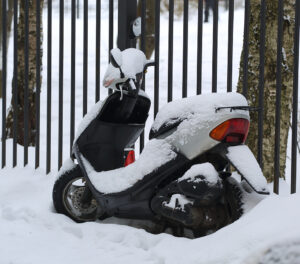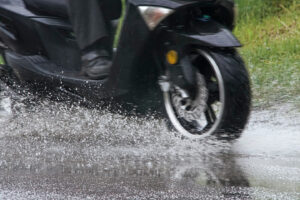By Rob Beswick, resident journalist
Winter riding
When the winter weather kicks in and every journey turns into a cold and wet one, we may wish that riding was just a summer pastime! But we don’t all get to choose the easy way out. If checking weather forecasts suggests really heavy rain, snow, or ice; a duvet day is justifiable and we won’t judge you!
Rain, snow and ice quickly make any ride less appealing, but with the right precautions, we can still get from A-B safely. The clue is taking extra care – and planning ahead.

If a trip is essential, extra time to make the journey, is critical. Even in moderately bad weather, slippery roads make handling a powered two-wheeler tricky, so we need to take extra care. Cut speed, take extra care on cornering and stay extra vigilant – no sudden moves. The last thing we want is to have to put the brakes on in a hurry on winter roads, as it’s a fast route to parting with our ride!
Don’t forget, other road users are dealing with the same conditions, so build in a wider safety margin on everything. More space between us and the vehicle in front, giving parked vehicles a wider berth, reducing our speed and giving ourselves more time to stop: all lessons better not learned the hard way!
It’s particularly important to approach junctions with more care, to allow time to react to other road users’ mistakes.
We are always best to avoid puddles – you never know if there is a pothole lurking beneath. But, riding at a reduced speed will also help pass through those unavoidable ones without aquaplaning, and help keep control if bad surfaces are covered by water or snow.

Top tips
- Even in the middle of the day, it’s important to ride with headlights and the tail lamp on when visibility is poor. The rear light is particularly important in wet weather for helping other road users see us. Your lights are probably designed to always be on, but check for blown bulbs.
- Keep vision clear. When riding in cold and wet weather, it’s easy for the helmet visor to become misted up as a result of condensation, so using an anti-fogging solution or product such as Rain-X on the visor, really helps and is easier than holding our breath.
- Yep, it’s been mentioned many times before but here it is again. Wearing reflective gear is a must and we can never assume we have been seen. Days like this are not the best time to practice your ninja skills.
- Try to keep warm and dry. Layer up and use the best waterproofs you can lay hands on – nothing is worse than riding cold and dreaming about our duvet.
